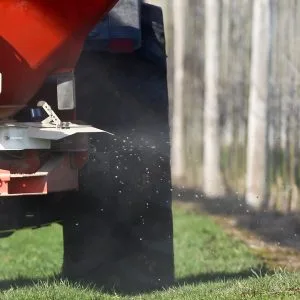Your lawn can’t always get enough nourishment on its own. Applying fertilizer gives it the fix it needs. Not only does it promote new growth, but it helps grass recover from foot traffic, drought, heat, and pest damage. And a healthier well-fed lawn wards off weeds better. Choosing fertilizer for your lawn can be confusing with so many kinds available. Here’s what you need to know.
Grass Type
There’s a lot to look at on the label when choosing fertilizer. First, know what type of grass makes up your lawn. Is it warm-season or cool-season grass? Most northern states have cool-season grasses like Kentucky bluegrass, fescue, and ryegrass.
Soil Type
You’ll also need to know your soil type. If the soil pH is too high or too low it affects the ability to absorb nutrients. Average pH is approximately 6.5, but depends on the type of grass. Lower numbers mean higher acidity and you should choose a type of fertilizer that’s beneficial for that condition. Get a testing kit from your local garden center.
Ratio of Nutrients
Every bag of fertilizer has three numbers that represent percentages of nitrogen, phosphorus, and potassium. You need a ratio of these nutrients that corresponds with your lawn’s needs. A lawn expert can help here if you are uncertain.
Amount of Fertilizer
Most fertilizer bags are sold by the amount of area they cover. If you treat the whole yard, calculate the square footage by multiplying its length by width.
Formula
Most fertilizers come in either quick-release or slow-release formulas. Quick-release granules provide nutrients fast, as its name suggests. If you’re looking for a quick green-up, use this type. But be careful: quick-release fertilizer can cause damage like grass burn. Follow instructions carefully. Slow-release granules require more patience, but have longer lasting effects. It also means fewer applications.
Spreading Method
After choosing fertilizer, there’s one more choice to make: method of distribution. Using a spreader is the best method for applying fertilizer consistently. However, if you are treating a small space or don’t have a spreader, apply it by hand. Wearing gloves and walking backwards, toss the fertilizer in a sweeping motion as evenly as possible.
There are two types of spreaders, broadcast and drop. Also known as rotary, broadcast spreaders better disperse fertilizer over larger areas. A drop spreader distributes in even rows and works best in areas that need more precise coverage.
We Can Help You Choose Fertilizer to Fit Your Lawn’s Needs
Give your grass the nutrition it needs and it will reward you with a lush green foundation for your landscaping. We’re happy to help you make the right decisions. If you have questions about choosing fertilizer, or you don’t wish to do the dirty work, call us. Contact Free Spray Lawn Care at 419-529-5296 today and our experts will help your lawn get the nourishment it needs.



Comments (0)
Thanks for your comment!
Thanks for your feedback! Your comments have been successfully submitted! Please note, all comments require admin approval prior to display.
Error submitting comment!
There is a problem with your comment, please see below and try again.